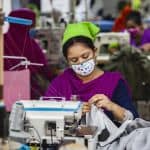What’s Ailing Sri Lanka’s Microfinance Industry – And Could Fintech Provide a Solution?
In Sri Lanka, unlike other emerging economies, financial access isn’t the problem. The country of 21 million enjoys a diverse range of financial institutions, with numerous formal, semi-formal and informal financial service providers. In fact, Sri Lanka has the highest commercial bank density in South Asia, with nearly 19 commercial banks per 100,000, according to 2015 World Bank statistics. Around 83 percent of Sri Lankan adults aged 15+ have a bank account at a formal financial institution, compared with a South Asian average of 46 percent.
Despite this high financial access, formal financial institutions are restricted from providing microcredit services in the traditional manner, due to the lack of collateral and regular formal income among low-income borrowers. As a result, only microfinance institutions cater to the credit needs of the low- and irregular income segments. Despite the risks involved, a number of leading banks have established separate microfinance units to provide microcredit services to women from low-income households. However, the ineffective regulatory system has resulted in high interest rates and a number of malpractices that have severely impacted customers at the base of the pyramid.
At Sparkwinn Research, we have attempted to contribute toward a detailed understanding of the market needs of the country’s microfinance sector. To that end, we conducted several focus group discussions and interviews with microloan borrowers, amongst women from post-conflict regions that were affected by the 25-year civil war in Sri Lanka – including the Northern province, where there is a significant number of women-headed households. After the end of the war, people had to rebuild their lives from scratch, as they had lost all their possessions, properties, etc. Yet due to the lack of economic and employment opportunities, they often had to rely on credit to do so.
Our research has focused on understanding the dimensions of the market, identifying the challenges in current practices and recommending growth strategies accordingly. We’ve found that while the market is struggling with legacy business practices and an ineffective regulatory system, there are several advantages that Sri Lanka could leverage, particularly as financial technology innovations continue to advance.
The State of Microfinance in Sri Lanka
Microfinance is often promoted with the objective of providing affordable financial services in a fair and transparent manner to those excluded from the formal financial system. But the context is different for the microfinance sector in Sri Lanka, due to its low population and high financial access relative to other emerging economies.
In Sri Lanka, microcredit is offered to finance income-producing activities with the goal of promoting local entrepreneurship. However, our research reveals that only a handful of the disbursed loans were used for entrepreneurship or income-generating activities. The low-income population’s needs are more inclined towards obtaining small, medium-tenured loans to fund emergencies, cash shortages or consumption-related expenses.
Unfortunately, microcredit clients are subjected to exorbitantly high interest rates, some as high as 72 percent. The rise of commercialization and the lack of regulations on interest rates compromise borrower consumer protection. The interest rates charged by some MFIs are even higher than the interest charged by loan sharks, which averages around 40 percent.
Due to these expenses, many households get trapped in severe debt and stuck in poverty cycles. With rising indebtedness, entire families face serious consequences including depleted savings, psychological stress and shame, and the need to pawn assets or seek out additional borrowing to repay loans. Suicides among microloan borrowers (over 90 percent of whom are women) are highly prevalent within the post-conflict regions we studied, linked to harassment and public humiliation by the agents due to default in repayments.
Even so, interest rate caps aren’t imposed, in order to allow market forces to determine the prevailing rates. For an MFI, the need to cover operating costs should be one of the most important factors in setting an appropriate interest rate. However, our research shows that MFIs actually incur minimum transaction costs due to the widely practiced group lending model.
Exploitative labor for loan disbursement and management
Group lending requires excessive interaction and participation from microfinance agents and borrowers. Microfinance agents (who are also borrowers at the MFIs) function as group leaders for their particular area, usually within their neighborhood. Loan officers, formally employed by the MFIs, liaise with these microfinance agents to ensure the smooth flow of operations.
Group leaders/agents perform most of the operational work at no cost to the microfinance institutions. They regularly coordinate with borrowers and ensure the payments are ready for settlement during the loan officers’ weekly visit. The agents also perform other operational work, such as assessing the credibility of borrowers and arranging for loans based on their past experience with the borrower.
Microfinance agents must incur significant monetary and time costs to ensure smooth operations. They charge a small commission to the financially struggling borrowers for the operational tasks they perform. MFIs motivate the agents with benefits, such as providing opportunities to obtain additional loans, or to take part in annual raffles, etc. But their financial responsibilities to these agents remain minimal. Combined with their high interest rates, this model delivers substantial profits to providers – but significant downsides to agents and customers.
A Way Forward
With their high profits, low expenses and lack of competitive pressure, Sri Lankan MFIs are often reluctant to adopt technology to achieve higher levels of operational efficiency. This defeats the whole purpose of promoting commercialization to increase efficiencies and provide affordable services.
However, the potential for the effective use of this technology is clear. The country’s existing technological and financial infrastructure could be utilized as platforms to streamline microfinance operations. Its wide network of ATMs and bank branches could be used as integration points for repayments. And its advanced mobile infrastructure could be leveraged to enable access and efficiencies: Sri Lanka has more mobile phone connections than it has people, and its smartphone usage is growing fast. According to GSMA Intelligence, the country had the second largest increase in smartphone adoption in Asia in 2016, second only to the Philippines.
A report published by McKinsey Global Institute in 2016 states that mobile payments can lower the cost of providing financial services by 80 to 90 percent in emerging economies. And countries with less developed financial infrastructure and lower mobile penetration than Sri Lanka have already incorporated technology into their microfinance operations as part of their journey toward achieving financial inclusion. However, only 0.1 percent of Sri Lankans had mobile money accounts in 2014, according to World Bank Global FINDEX indicators – and though this number has surely increased since then, adoption remains low. Limited agent and distribution networks to top up mobile accounts are some of the key reasons for this slow uptake.
Developing its inclusive digital payments platform would reduce costs, increase transparency, boost productivity gains and help eliminate theft in Sri Lanka’s microfinance sector – all of which would advance financial inclusion, women’s empowerment and inclusive growth. Yet fintech-related innovation within its financial industry is very rare. That’s largely thanks to regulatory restrictions, which protect established financial institutions in Sri Lanka (including MFIs) from technological innovation and disruption.
Regulators need to ease some of these restrictions while strengthening the country’s regulatory framework in favor of the borrowers/financial consumers. Numerous fintech innovations can emerge if favorable regulatory conditions establish a healthy environment for them. This would eventually provide competitive services to the people – which, along with appropriate consumer protection regulations, would lower the cost of these services to the poor. Enabling fintech-related innovation and effective regulatory frameworks to protect poor borrowers is essential to uplift the lives of Sri Lanka’s most vulnerable communities.
Photo from World Bank, via Flickr.
Suthaharan Perampalam is head of social research at Sparkwinn, a social and market research agency.
Mithula Guganeshan is research manager at Sparkwinn.
- Categories
- Finance, Impact Assessment



